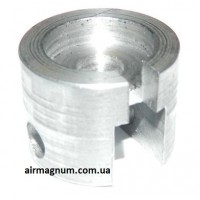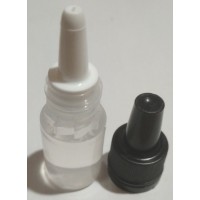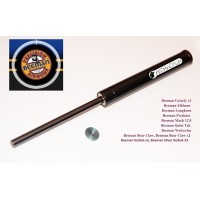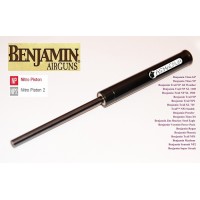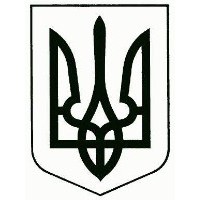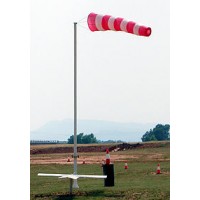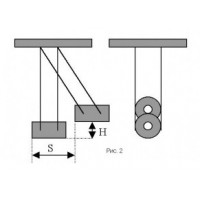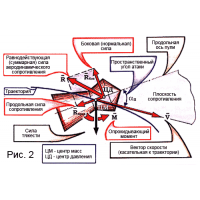About optics and its choice
Optics selection and sighting
Quite a lot has been written about optical sights, so I see no reason to dwell on their device in detail again. We will talk about the problems that you will have to face when choosing and installing a telescopic sight on an air rifle.
If you look into the store of the corresponding profile, you will find that there is a choice. But when choosing a suitable sight, you will have to be guided not only by the thickness of the wallet, but also by the ability to do something with your own or someone else's (again a wallet !?) hands.
A typical scene. Buyer: I would have a scope for pneumatics. Salesperson: Here, please, this one. It's just specially for pneumatics! Moreover, it is already with fasteners! What rifle do you have? What you need! The guys took it! Class !!!
In principle, this scheme works. You do buy, bring home, install, and of course shoot. If everything suits you, then you can not read further.
What may not suit you: a bit dark, unclear, low magnification, it creeps (sight), I can't hit a mosquito at 30m, I can't hit a soccer ball at 3m, Yes, I don't look like a sniper with such a device!
There is another scenario of dialogue in the store. Seller: what difference does it make to pneumatics or something else, the sight, it is the sight. There are so many of them! The guys took this one! And here are the fastening rings, just for him, you and your rifle. What is yours? It will go! And then, as in the previous story, we bring, install, shoot. If everything suits you, stop reading.
Yeah, you read. Because at close range to the target (within the apartment) it is impossible to get a sharp picture, although if you aim at the neighboring house, then everything is fine (I said just aim, and what did you do?). Well, as a result, accurate shooting is difficult at a short distance.
And you have already managed to twist everything that is spinning, and you still cannot achieve hitting the aiming point, the bullets stubbornly fall below. And the aim is somehow not very convenient. This is understandable, because now you have to touch the butt not with your cheek, but with your chin (unless you have a sporting weapon in which everything is adjusted).
Despite the hiss of pets, shooting continues, and at some point it is discovered that now the sight is much closer to you than immediately after installation.
It begins to seem that the weapon without optics fired more accurately.
Suddenly it turns out that the weapon (with such optics !!!) cannot be carried from the entrance to the car, the grandmothers react inadequately and rush to the phone to dial a two-digit number.
The listed problems can be solved. Let's talk only about those that are affected by the sight and (or) its fasteners. With the rest - to the doctor, this is not a medical page.
So we have two options.
The "first" is a scope with an objective lens of 15mm or less and a tube of 20mm or less. Outwardly, this is just a stick with fasteners of one design or another, and such a sight was created specifically for pneumatics.
The "second" is a device with a 25-40mm objective lens and an eyepiece of a similar size, tube diameter 25.4-26mm, sometimes 30mm. Outwardly, it vaguely resembles an hourglass. As a rule, without fasteners, it was created as a sight for firearms. This is how the Russian market looks like, with some exceptions, of course.
Let's start with the minimum target distance. As a rule, for pneumatics it is 8-10m. These are the very numbers from which the problems begin. We want to have a sharp picture at both eight and eighty meters, in other words, we need a great depth of field. This is easily achievable with a small objective lens and an acceptable, about 4x, magnification of the entire device.
We want to shoot the weapon at a short distance, i.e. the aiming line and the trajectory should intersect at a certain point, 8-10m away. The lower (closer to the axis of the barrel) the sight is set, the easier it is to cope with this task. Low-mounted optics will make you feel as comfortable as with a standard open sight, in any case, the weapon's engagement will not fundamentally change. This is also a plus in favor of the first type of scopes. And, of course, light weight.
Anyone who believes that weight does not matter, but has a desire to wander through the woods with a powerful air rifle equipped with good, high-aperture optics, I recommend that you know these sensations in advance with the help of some weighty, 4-5 kg object. The most common scrap is an excellent weight model of a really powerful rifle equipped with a "Type II" sight. In addition, a light scope is less creeping than a heavy scope. This is where the advantages of the "first" are over.
"Type two". As mentioned above, it has a vivid and bright picture, which lacks sharpness at close distances. This is simply explained by the lack of depth of field, with "far" focusing. The fact is that we have to deal with sights made for use on firearms, where the distance to the target is ten times greater than when shooting from pneumatics. These scopes are focused at 50-150m and have a relatively large lens.
And the rule is this: The larger the objective lens diameter, the shallower the depth of field, all other things being equal. The higher the magnification, the shallower the depth of field, with the same lens diameter and other things being equal. Here it is (depth) and does not reach short pneumatic distances. How to deal with this - a little later.
And one more unpleasant thing that you will have to face when using the "second type" at pneumatic distances. This is parallax. I dare to assume that you already have at least one sight on your farm, so without further explanation I suggest you just see what it is. It is necessary to fix the sight in any available way, for example, clamp it in a vice. The main thing is to provide conditions under which you can see any contrasting target, preferably a straight-line shape, and, without touching the scope, observe what is happening with the reticle.
Try to move your eye relative to the eyepiece in any direction (transverse, of course). What do we see? We see that the reticle is moving relative to the target, the distance to which, for example, 20m, re-aim at something 10m, or for example 40m, and repeat the exercise. Sooner or later, there will be such a distance to the object at which this phenomenon is absent, for example, it is 50m. Congratulations! You've just learned what parallax is and how far your scope is focused.
Parallax is a common phenomenon in all riflescopes and any riflescope is only adjusted to one distance. Except for scopes with adjustable lenses. Unfortunately, such scopes are rare in our market.
You are probably already wondering how to live with this parallax, and how does the firearms community deal with it? Very simple, with a sight set for 100m. when shooting at 300, parallax is practically invisible, and therefore does not create any noticeable problems. But at short ranges, parallax can have a significant impact on shooting accuracy. The effect of parallax can be reduced to zero by doing nothing at all, only one thing is required - to ensure that the eye is always located in the center of the eyepiece. Of course, this must be remembered.
Now - about the blur at short distances. It has already been said above that the larger the lens, the shallower the depth of field, i.e. By reducing the size of the objective lens, the depth of field can be increased. How to reduce it (lens)? Very simple, you need to create a primitive diaphragm, as an option, use a piece of cardboard with a small hole 3-7mm in the center.
If you now install this "device" in front of the lens and look where everything was not sharp just now, you will find that the picture has darkened, but has become much sharper. The brightness of the picture will be approximately the same as in a diopter sight, or slightly lighter, it all depends on the characteristics of a particular optical sight. It's not radical, but it works. In any case, this is a real opportunity to shoot at short distances at an illuminated target.
Making the final version of the diaphragm depends on your capabilities and imagination. It could be the same cardboard, a sacrificed lens cap, a custom-made washer, etc. It is only important here that it is securely fixed and does not jump off when shooting, and, if necessary, can be easily removed.
Of course, there are other, more surgical ways to change focus, but this is a topic for a separate article. I foresee the question, is it worth it to fence such a garden, can buy "pneumatic optics" and not suffer. I answer, you don't have to suffer, it's all up to you, it's just that everything is learned in comparison.
Let's move on to the ring exercise. What should be the rings or bracket (s) to mount the optics? The height of the bracket is selected depending on the specific sight, weapon, and (or) other considerations. There are high mounts, with a window at the base, below the telescopic sight. This design allows you to use both a standard open sight and an optical one.
Material - steel or duralumin, silumin is undesirable. But again, it all depends on the specific case, for example, if an aluminum optics guide (aka dovetail) is installed on the weapon, do not mount the sight on steel rings, but use duralumin.
Another example. You have a powerful rifle and a heavy scope. In this case, you will certainly come across the fact that the optics with the fasteners are constantly shifting, and if you tighten it harder, then cracks will most likely appear on the fastener, if it is made of silumin.
Okay, let's say everything is purchased and installed. It's time for test shooting. Ideally, we would like to have the following result: When shooting at 10m, the hole in the target is located 4-6 centimeters above the aiming point, provided that the correction handwheels on the sight are "at zero". "Zeros" mean true ones, not the ones that are printed on the limbs.
We search for "true zero" as follows: turn the handwheel "from edge to edge" and count the revolutions. Let's say we counted four, now we count exactly two revolutions from one of the extreme positions and, thus, we get "real zero". We do the same with the other handwheel. The zero shown on the dial can be dealt with later.
Let's go back to test shooting. I doubt that the first time everything will be as it should, but if you received such or a similar picture, you are very lucky. Most likely, the weapon will shoot lower, and even to the side. This happens for several reasons. One of them is the non-parallelism of the barrel, in relation to the dovetail, on which the sight is installed.
In addition to the negligence of weapons manufacturers, who do not bother with excessive parallelism of their products, one should not forget that now we are in the "pneumatic world", where everything is somewhat different than in the world of firearms, different speeds, distances, angles, etc.
Therefore, whatever one may say, but for pneumatics, the angle between the optical axis of the sight and the barrel bore, as a rule, should be somewhat larger than on a firearm. Plus, the design features of the rifle itself affect the increase in the sight angle.
A weapon with a barrel mounted coaxially with a compression tube, which in this case is a receiver, and on which a guide for sights is installed, will require a larger preliminary sight angle than, for example, a rifle in which the axis of the barrel extends above the axis of the receiver. and the guide is made by milling the receiver itself, and not as an additional part installed on top. The optics, set at the "right angle", allow you to shoot without problems at targets located at a distance of 5m. until .... Well, it depends.
We continue with the installation. Let's take the worst case, called "everything is wrong." First, let's try to swap the rings. It certainly won't help radically, but it's worth a try, because the more correct the initial situation, the less unnecessary work. If the situation is not too bad, you can try to get by with pads under the sight, made of aluminum or copper foil, the same width as the ring.
You should not get carried away with this, the thickness of the foil should not exceed 0.2-0.25mm. Otherwise, there is a risk of bending the sight tube, and (or) getting a heavily overloaded structure living its own life. One of the manifestations of "my life" is the need to re-shoot the weapon after taking off and putting on the optics.
So let's do it right. This "correct" is not at all like a pleasant fuss with a children's designer, but is a rather long and tedious task. As a consolation, I can only say that this work will have to be done only once, after which only shoot and rejoice for the rest of your life.
To carry out the adjustment, you will need a certain special tool, which is something even, round, having a diameter of 25mm and a length of 300-400mm.
Someone for this purpose uses a steel blank, which in a past life "worked" as a guide in some mechanism, this is a rather heavy contraption, but it works. Something lighter, such as an aluminum tube, would be preferable, but what is there is usually used. You will also need sandpaper. These components should result in something like a round file, of a very suitable size.
The rifle is fixed in one way or another, for example, in a vice. To remove or not to remove the stock, as well as how to fix the weapon without leaving a trace, decide for yourself, this is not the question that should be dwelt on in detail. Since everything has tolerances, including the uniformity of the milling depth of the dovetail, the rings should be screwed to it, preferably in those places where they will always be located.
Since at this stage there is already clarity (I hope) where the scope is looking, and where it should look, we wrap the tool with sandpaper and proceed to processing. If you know what a file is and how to use it, then everything will work out. The purpose of this activity is to align the scope in a vertical plane, and make it look down, at an angle, in relation to the barrel, and the rings fit the entire width of the sight. Obviously, a pretty decent amount of metal will have to be removed from the front ring.
As a result, you should have a very rigid structure without local stresses. Not so tough, however, as to deliberately, too zealously, test it for strength, and not enough to use the scope as a handle for carrying a weapon. All for which I had to work so hard was the ability to shoot accurately, forgetting the day when you last zeroed in. However, if you like to engage in sighting and not shooting, do it your own way.
Now about what to do if the sight does not want to sit in one place, and when firing moves towards the butt, and together with the fasteners. Options to choose from. Tighten tight. If that doesn't work, apply LockTite and tighten again. LockTite is the name of the manufacturer of all kinds of auto chemicals, and is sold, of course, in the same place as spare parts for cars. You need number 243, which is a small red vial with a blue liquid. The tool is easy to use. Unscrew the bolt, degrease, apply two or three threads, tighten again.
The main positive side of this drug, in comparison with any "super-glue", is that if you need to dismantle, you do not have to break the tool, bolts and your psyche. It is enough to heat the head of the bolt with a soldering iron, and you can turn it off. If for some reason you do not like this solution, you can put a stopper on the dovetail, against which the sight fixture will rest. The stopper is like the lower part of the bracket, without a ring on top, but has a screw or pin that must go into the corresponding hole in the rifle. Not every rifle has this hole, so drilling may be necessary.
Some rifles have their own limiter. In general, the best option for mounting optics is a product that is not two independent rings interconnected by a sight pipe, but quite the opposite, the rings are connected by a common platform, the lower plane of which has a dovetail corresponding to the weapon. As a rule, such a bracket does not need additional locking devices and auto chemical products.
Next steps and some tips.
Grab an unloaded rifle that just got a telescopic sight and aim at something vertical. If there is nothing you have no doubts about verticality, use a plumb line. Hold your weapon the way you always hold it when you shoot. Make sure the vertical grid element is parallel to the plumb line. If not, correct the situation by rotating the scope. Tighten the screws and aim for the plumb line again. Verticality must be dealt with before zeroing in, not during or after.
Let's continue. After the last screw is screwed in, but before the start of zeroing, engage in vision correction, if, of course, the eyepiece design allows this. This is done quickly and correctly. Aim to aim at something light and non-specific, best of all in the sky. You don't need to look at the sky, you don't need to look at anything at all, including the reticle. If you look at it for a long time, the eye adapts, and you will see everything sharply, later it turns out that it just seemed to you. You just need to glance at the reticle, and if its sharpness is not enough, rotate what it (sharpness) is controlled by.
A quick glance at the net again and adjustments if necessary. And so on until the desired result is achieved. Tighten the lock nut on the eyepiece (if there is one), tighten it more firmly, there should be no movement of the eyepiece. Make sure once again that the reticle has the proper sharpness, and forget about this adjustment forever, unless, perhaps, in the event that your vision suddenly improves.
Aim your rifle. Do not forget to explain to your friends that the scope is not theatrical binoculars, so you do not need to twist anything.
And further. When choosing an optical sight, inspect it for scratches on the lenses, as well as dust and other foreign bodies. Having paid for the purchase, do not rush to celebrate this event, remember that this is not a telescope for examining distant objects, but an optical device with which you are going to target these very objects.
Therefore, gallop home in order to quickly get started with the installation. You don't need to adjust anything, just set it as it is, that is, if the sight "looks in the wrong direction", do not pay attention to it, let it look wherever it wants, if only to the same point. Further. We hang a sheet of paper and open a heavy fire. The purpose of the event is to check for penetration.
Having designated the aiming point, we fire a series of shots, following the principle that the more shot the better. If all the bullets land right where they were aimed (lo and behold!), Arbitrarily turn one or both handwheels, since it is not necessary to hit the aiming point now, the point must remain "alive".
After the first series of shots, one ragged hole should be observed, the size of which does not exceed the usual size inherent in the particular weapon. After that, we turn each handwheel a few clicks in any direction, and again "fire". Then, counting the clicks, return the handwheels to their original place and shoot again using the original aiming point.
Let me remind you once again that you should not save on bullets when conducting this test, the more you shoot, the more accurate the diagnosis. Let's see what the result is. If we see a white sheet with two ragged holes, then everything is in order with the sight. If the shot through paper resembles a map of the starry sky, the sight is clearly defective, carry it where you brought it from.
The most likely internal defects are insufficient spring (s), loose lens (s), incredible manufacturing tolerances. Do not try to fix anything inside yourself, the probability of a positive outcome is extremely small.
And the last thing. Firearm optics are not designed for loads, including alternating ones, which are created by spring pneumatics. This does not mean that it will necessarily fall apart, but if this happens, you should not be surprised.
And yet, which scope to buy? Here are some guidelines.
Optics originally intended for pneumatic weapons, the one that is "Type One", does not differ in high quality and mechanical and optical parts, but, of course, has a lot of advantages (see above), and therefore the right to exist, but only as the first in the life of an optical sight. After dealing with a "normal" telescopic sight, you will never return to "pneumatic" optics.
When thinking about how much to spend on a scope, you should not rely on the cost of the rifle on which it will be installed. The weapons available may be inexpensive, but good and very accurate. And you buy the scope for yourself, not for her (the rifle), because it is you, one way or another (not her) will have to experience certain emotions. Well, in the end, the sight can later migrate to other weapons.
If the choice fell on the "fire" optics, then do not strive for a lens diameter of more than 32mm, with a magnification of 4 (why - see above).
It is also worth mentioning the variable magnification or pankratic scopes. They have the advantage over fixed ones in their versatility, especially when using the same rifle in different conditions. For example, when shooting at a long distance in good lighting or at a small distance with a lack of lighting, as well as with all other intermediate variants of shooting conditions, including various positions from which you have to shoot, lying down, standing, etc.
In a word, there are a lot of different wonderful sights in one bottle. But in this bottle there is also a drop of disgusting tar: such a sight has a large number of moving parts, which affects its reliability not in the best way.
The moving lens reversing system is a major design difference from fixed magnification scopes and is particularly critical to precision and workmanship. In short, if you need a sight for all occasions, and you are lucky in the lottery, this is just what you need.
Epilogue
In this material, I deliberately, whenever possible, avoided specific names of manufacturers and the names of specific models. I do not want to engage in advertising or anti-advertising, neither hidden nor explicit. And, in general, there is really nothing to advertise. There is simply no foreign Extra-class optics designed for spring-piston weapons on the Russian market, and the domestic one is represented by inexpensive "pneumatic" models for medium-power weapons.
So you will have to choose from "firearms" models of Russian-made and CIS-made sights. I must note that the Russian-made optics are still quite good, and without being "pneumatic", they are amazingly tenacious (with a few exceptions, as always).
If, nevertheless, you want something imported, do not take the word for it, look on the packaging or in the instructions for "for spring piston airgun" or a similar phrase. Stories about how wonderful this particular sight feels on a .30-06 caliber carbine can be listened to with interest, but not taken into account when choosing. They have their own return, and we have our own.
The word "powerful", in this article, means a rifle with a declared muzzle velocity of about 300m / s. All of the above, to a large extent, refers to the problems inherent in the spring-piston class. Optics installed on other types of pneumatics are not subject to any stress, so the choice of scope and fasteners is not a problem, but the requirements for mounting angles are the same.
Add-ons are possible.
V. Schmidt.
Related Products
Gas spring Beeman Kodiak x2, Beeman Silver Kodiak X2
Gas spring for air rifleBeeman Kodiak x2, Beeman Silver Kodiak X2Set:gas springcentering thrust washerinstructionpackaging High pressure gas spring (hereinafter referred to ..
376грн. 398грн.
Gas spring Benjamin Trail NPS
Gas spring for air rifle Benjamin Trail NPS Set: gas springinstructionpackaging High pressure gas spring (hereinafter referred to as HP). It is pumped with ni..
376грн. 398грн.
Related Articles
Order 2001 №53 / 213
Order of the Ministry of Internal Affairs of Ukraine dated 21.03.2001 №53 / 213"On Approval of Licensing Conditions for Economic Activity in Production, Repair of Firearms and Ammunition, Cold Weapons..
How does the wind affect shooting
How the weather affects shooting is known, in all likelihood, even less than the influence of other factors. There are many different considerations and theories as to how best to shoot in the wind an..
Order 1998 № 622
Затверджено &nb..
Ballistic pendulum
Ballistic pendulumMeasuring the speed of a bullet with a pendulum is available and serious.Probably, before any owner of pneumatic weapons the question arises - what is the real power of his pistol, r..
Ballistics of pneumatic weapons
At one time, a cowboy philosopher expressed the "wise" idea that the shortest distance between him and the target is a bullet. He was probably thinking of an imaginary straight line connecting th..

